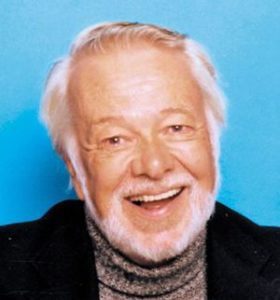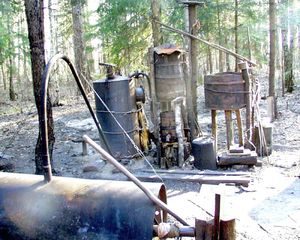This story was originally published in The Sylva Herald.

Local storyteller and playwright, Gary Carden. Photo from The Sylva Herald
Although you’re not likely to stumble across illicit moonshine stills in Jackson County today, 50 or 60 years ago, you stood a better chance.
Jackson County once played a starring role in regional moonshine production. It served as a hub for making and bootlegging the illegal liquor, according to local storyteller and playwright Gary Carden.
“Jackson County is in the middle of things,” Carden said. “It didn’t attract a lot of attention during the Civil War, but the moonshining was really here.”
A group of anthropology students from Pennsylvania State University traveled 12 hours for a two-week research project on moonshining in Western North Carolina, meeting with Carden in his Sylva home.
The “Moonshine Archaeology” project looks at the social and economic impact of moonshine production throughout WNC.
“No one is going to admit this, but economically, moonshine made it possible for Appalachian farmers to survive,” Carden said.
The local storyteller is serving as a key source for Penn State archaeology lecturer Kirk French and four of his anthropology students, Carly Hunter, Elijah Hermitt, Caitlin Donahue and Cayt Holzman.
The “Moonshine Archaeology” team decided to research Jackson County after French watched Neal Hutcheson’s Appalachian moonshine documentary, “The Last One.”
“Someone put that movie in my mailbox at school. They thought I’d like it, because I’m from Texas, and they think it’s all the same if you’re from the South,” he said. “The thing is, they were right. I loved it.”
He said students enjoyed the documentary, too, because it focuses on alcohol.
French got in touch with Carden through film director and producer Hutcheson, who, in addition to the documentary that sparked French’s interest, has produced several films regarding Appalachian history, heritage and moonshine.
One of Hutcheson’s films, “Prince of Dark Corners,” is based on a play written by Carden about the life of “Major” Lewis Redmond.
“At one time, he was in the New York Times as the most dangerous man in America,” Carden said of Redmond. “That was a lie. He never killed anybody but one guy – and he needed it.”
Another Hutcheson film, “Mountain Talk,” was narrated by Carden.

Photo from The Sylva Herald
French said the idea of looking at moonshine stills – archaeologically speaking – came from watching these movies and thinking about the stills that were abandoned by moonshiners.
Not everyone approved of how the films portrayed moonshining, according to Carden.
“It’s a very common theme in mountain people,” he said. “People who have been raised to be ashamed of moonshine and to consider it criminal. If God didn’t approve, then no one wanted anything to do with it in a good Pentecostal Church.”
The professor and students’ project extends outside of Jackson County. They are also attempting to find abandoned moonshine-making sites throughout WNC.
“I’d say that’s extremely rare now,” Carden said with a laugh. “You’re much more likely to find a pot patch these days.”
“Archaeology isn’t just temples and palaces and arrowheads, it’s also a moonshine still,” French said.
He thought the group would have a better chance of finding abandoned stills in the federally protected forests of WNC.
Because it’s illegal, there’s no public documentation to serve as a map.
“People say you can look at arrest records, and that’s bologna, because some sheriffs would turn a blind eye and others arrested everybody they could find,” French said. “So, if you went by that, you would have a skewed view of what was actually going on.”
Another angle of the “Moonshine Archaeology” is focused on ethnographics. The group will interview people in WNC about their experience with moonshine and try to find abandoned still sites guided by old stories.
“The landscapes are going to tell one story, and the people of different ages and different backgrounds in this area are going to tell a different part of the story,” French said.
“My father was murdered by a drunk, and that had a profound effect on the family,” Carden said. “Suddenly, drinking was an anathema, you just didn’t do it. I even felt guilty when I drank beer.”
Carden said buying and drinking alcohol was, for him, akin to living a second life.
“I think the first drink of alcohol I had was from a woman who drove the school bus. She came out to the car with a Mason jar,” he said.
Carden regaled the group with a story about visiting Whiteside Cove during his high-school years accompanied by friends.
“We were cutting firewood, and I dug up a sack in a brush pile. We got a knife, opened the sack and it was full of quart jars of moonshine. We were just kids, we were 17, and we used it to start a fire in the fireplace.”
He said he was told the moonshine was left there by a well-known moonshining family, who were waiting on a middle-man to pick it up and sell it.
A lot of moonshiners used the middle-man strategy to bootleg moonshine, he said.
“They even had decoys,” Carden told the students. “When I was a teenager in the 1950s, we got offers.”
He said moonshiners would tell kids to take their car, drive to a particular hospital and park in a specific lot. Then, the driver would get out and go in the hospital for at least an hour – all without opening their trunk.
“You drove down there, went in, came back out and drove home with $20. That was a fortune back then,” he said. “I wish I’d had the guts to do it, but I didn’t.”
He said moonshining didn’t always have so many stigmas attached, however.
“If you look at the old Scottish and Irish cultures, it’s the water of life,” he said. “George Washington, Thomas Jefferson, all of them were moonshiners. They raised corn, they made whiskey and they sold it on the river. It wasn’t against the law. It was a respectable product.”
The culture surrounding moonshining continues to evolve.
“There’s all kinds of people making a good living out of moonshining now,” Carden said. “There’s restaurants who serve it. I think you’ll see that more and more.”
The “Moonshine Archaeology” team plans to create a five-minute film about the project to show at the Society for American Archaeology conference next April.



